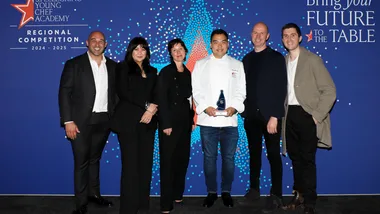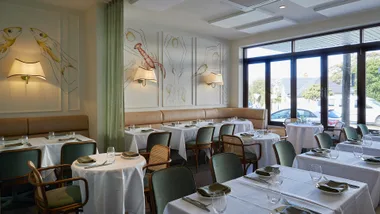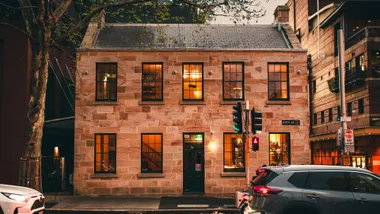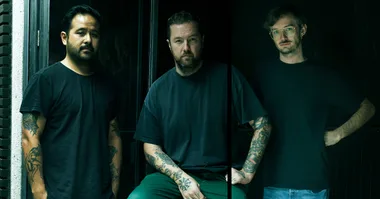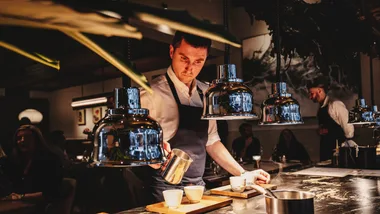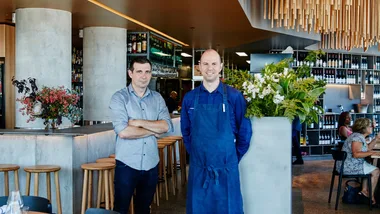David Chang
What is Momofuku Seiobo now?
David Chang: I think what it is now is a restaurant that’s running at a very high level. It’s much more ingredient-driven than any of our other restaurants because the shellfish, the seafood, the proteins are just so good that it’s simpler but more complicated. It’s more Japanese in its aesthetic. We’re able to do a lot more because the kitchen’s so nice and we have so many tools at our disposal, and our team is really good. For the most part everybody’s been there from the start and we’ve really grown as a team there, particularly [chefs] Ben [Greeno] and Chase [Lovecky] and Clayton [Wells] and [sommelier] Richard [Hargreave].
I’ve never had a front of house team like what we have at Seiobo, so it’s been a convergence of amazing talent and working to the strengths of what we can cook. In terms of the food it certainly started off with the DNA of some of the things that were Momofuku, but it’s rapidly turning into what I think is Australian food. For the most part we’re only using Australian produce, and we’re doing whatever we please, whatever we think is delicious. We’re also working on service, to bring back some older types of service and a different dining experience for the people who are sitting down at the tables. We’re slowly accumulating the stuff we need to do some classic French stuff there, and I think that the bar menu has evolved because the guys have realised that it’s the most fun. They finally embraced the fact that that’s the kind of food that people want to eat on an everyday basis. So all in, Momofuku is a little bit of everything now. We have a great wine program, we have great cooks, great produce, and we have this weird thing going on in the dining room and somehow it’s all coming together. I think that by not saying that it was going to be something in particular when we opened, it’s allowed us to create this experience that’s continually evolving.
What we want to do is reflect the best of Australia. I honestly have a hard time going back to America because whenever I’m in Australia I’m dumbfounded at the stuff we can work with. Not everything’s better. I don’t think the vegetables for the most part are better. But working with farmers and trying to find more native ingredients has been one of the great joys for the team there.
So in short?
Momofuku has been about discovery in Australia. About what we can do, what we do and don’t do well, and everything seems new. One of our goals was to dispel ideas of what it meant to be a casino restaurant and try to do something that we’ve never done before. I have a hard time describing Momofuku food, and I have a much harder time describing the food we do in Sydney.
Do you feel like they’re still connected, though, part of the same family?
Certainly part of the same family, but it’s really taken on a life of its own. It’s what we wanted to happen – to have this dialogue. The dishes are distinctly different there. The ingredients are so pure we don’t have to do as much, and it’s much cleaner. We can really focus on three ingredients on the plate, and that’s been the goal this past year, to focus on three things on a plate. It’s a lot easier to do that when we have amazing fish, or this amazing marron, potatoes. (For whatever reason, I think Australian potatoes are delicious.)
I think in Australia, because you’ve got access to so much, I think there’s sometimes a tendency to do too much. What Momofuku has been is an exercise in addition through subtraction – particularly in how we cook. And we have that luxury in Australia that we don’t have in New York, particularly because we don’t have the space, the equipment, we just don’t have the firepower to do that at [Momofuku] Ko. For instance, the food at Ko is very different, and it’s the same in Toronto at Shoto, our other high-end restaurant, where we use more spice and so much more on the plate because it almost needs it – the product is not as good. It’s getting there, but it’s a work in progress. Each one is distinctly different.
Thankfully.
It would’ve been easier just to sell the same menu at each one, trust me.
What’s this French stuff going on at Seiobo?
We’re interested in bringing a unique dining experience to the people who are sitting at the table rather than the counter. Sometimes people sitting at the tables want the counter experience, so what we’re trying to create is an experience where if you’re sitting at the counter you want to be at a table and vice-versa. The best way we thought we could do that was with some tableside service. It’s a slow process, and we’re in no hurry to unleash the whole French thing until we’re ready. I like that situation where everybody wins, but they’re like, why didn’t we get what those guys got?
Do you have plans for more restaurants in Australia right now?
We’re in talks to do more, and we are blessed with such a good team in Australia that we’d like to do more stuff. There’s a variety of projects we’re looking at – something more casual, perhaps, more accessible, and very different. I think it’ll allow us to have more fun, and those projects are going to be about showcasing the talents of Richard Hargreave and Ben Greeno, and Chase Lovecky from New York. Ben has really grown, and so has Chase – he’s just crushing it. We’re gonna be opening up restaurants that – if and when they happen – are gonna be a showcase for those guys, because those guys make everything happen.
What about in North America?
No – this has been a year to decompress. We have literally nothing in the pipeline. It’s been an insane three years of getting restaurants open. They’re very far apart, so that’s been challenging. Now we’re focusing on what we’re doing in New York and the lab, and all the fermented products we’re making. We had a great opportunity to open up in Australia to do – well, I wouldn’t say a flagship, but something that nobody else would give us, a 32-seat restaurant with my dream kitchen and the chance to assemble a crack team. That’s not the sort of opportunity you can turn down. We’re very lucky that people want to open up restaurants with us, and right now we’re going to wait till growth seems like a good idea. We’re not just going to open up a new restaurant because we have to open up a new restaurant. Expansion in Australia seems like a good idea to me because we are so stacked with talent at Seiobo right now that if we don’t remove some of the top-level cream, we’re never gonna develop any of the younger talent. And it would give Ben and Richard and the guys the opportunity to let the whole thing grow organically. That’s the kind of growth that most interests me, and we have the same philosophy in New York and Toronto.
What’s your role now?
I don’t know. I don’t necessarily like my role. There are worse jobs. I joked that I create the jobs that I want and never get to have. The job that I wanted is really Ben’s job, and before that it was creating the lab position in New York, which is an awesome job. I think that my days of working at the pass every day are certainly coming to an end, if they haven’t already. Partly because physically I’m not there, and it’s hard constantly adjusting to time zones and all the new people. I’m learning how to be an asset and to be of value. More and more I’m learning how to be an editor and how to delegate more. I don’t have to teach Ben exactly how to do it any more; I can just coach him. No day’s the same. I’m just getting used to it.
The reality is, in Australia, if and when we open another restaurant there, I’m not going to have to spend as much time creating the culture, and with that already in place I can focus on other things there. So I don’t know what my role is, really, except that I’m like this travelling salesman. I took some time off this year, and what I learned is that I like to work. I care too much to unplug.
It’s good to have a job that you sort of sometimes like, sort of.
At the end of the day I’m a very lucky guy.
The luckiest peach?
For sure. And for all that good fortune, I feel like that’s all the more reason for me to keep my head down and try my best to keep navigating. My job is to help people to be in the best position possible to succeed.
Ben Greeno
Momofuku Seiobo then and now: what was it like when you first opened?
Ben Greeno: It was very high profile and there was tonnes of pressure. I think I was trying too hard to make it like a Momofuku restaurant. Now it has its own personality and, as much as it keeps in with the Momofuku thing, it’s its own restaurant.
What was a Momofuku restaurant, as far as you were concerned?
I was thinking very Americanised, and it took me a while to realise that probably wasn’t the best way to do it, and it probably wasn’t what Dave wanted either. What is a Momofuku restaurant? Who knows. I can’t answer that question, but I have a strong feeling of what Seiobo is. We don’t need to set the menu any particular way or follow any particular influence. It is what it is.
You change your menus a lot more often than most restaurants working at this level. What’s that all about?
It’s just how we work. If we get something amazing in that we want to use, we’re going to use it. It’s not like we’re going to hang out and wait until it’s a menu change or something like that.
You’ve built a steady group of regulars in the short time you’ve been open. What is it that they’re coming back for?
I think it’s just that they can eat good food in very relaxed surroundings. A lot of people want to go out, but they don’t want to have to do the white tablecloth thing and the four-hour dinner. It gives people a different option.
Are there any misconceptions about the restaurant that you’d like to dispel?
That it’s really difficult to get into. It’s not. Midweek you can get a table fairly easily and we generally try and keep back a walk-in table, and then there’s the bar food, though that’s getting busier now. It’s a very strange restaurant in the way it divides people. One night, not too long ago, we had a table of four sat on 33 and a table of four sat on 31, which is two tables diagonally across from each other. The four girls on 33 were over the moon, blown away, loved it, had a great time and said they wished there could be more dining like this. The table on 31 hated it, didn’t like any of it, couldn’t understand why you’d serve food like this in these surroundings with all this music, and it was one of the worst experiences of their lives. We’re always going to divide people. Always.
What is it specifically that’s so divisive?
People don’t like the dark and the music. Maybe we should buy some candles. Maybe some of those candles that play tunes.
They could all play Pavement.
Please don’t suggest that. You never know. Dave could be, like, “that’s a great f***ing idea”.
Around the fringes of your menu you’ve got a bit of French gear going on – is it just because you can?
Just because we can, yeah. It’s so much fun just being able to do stuff like that – a rabbit terrine with black truffle. We can do it, so why not make the most of it?
It’s a pretty amazing opportunity for you to have landed as your first head chef gig – you’ve got a kitchen kitted out with the best stuff, you appear to have the trust and support of the restaurant’s owners and executive chef, and it seems like you’ve moved past the freaking-out stage, taking the fancy car out of the car park and onto the road to get a sense of what it can do. Where are you at now – are you just warming up, or are you about to click into cruise control?
We’re just warming up. You look at this restaurant from what it was when we opened and it’s a completely different place. We’re a lot more relaxed, but we’re certainly not in cruise control. I can really feel that it’s moving in the way we want it to be moving, and we’ll see how it goes.
Who comes to work at Seiobo? What attracts them?
It’s all sorts of people. Our last employee just did two years at The French Laundry, and then we have a guy who runs our pastry now who used to run the kitchen in a pub in Darlinghurst. And like everyone else in the city we get a lot of guys on traveller visas, and after six months that’s all they can do.
And what can we expect from Seiobo in the six months or year to come?
What can I reveal? You can see from things that we’re posting on Instagram and things that we’re experimenting with – things like the rum baba that they serve to you at the table like they do at Ducasse. It’s an old-school thing, and I’ve been reading a lot of Ducasse books this year, and we found a stash of old, very good silver at the casino which no one uses any more. It’s just sat in a cupboard and nobody’s using it, so we’re like, f*** it, let’s use it. We’ve got all this stuff, so we need to do things with it, so let’s see how it goes.

 Chris Chen and William Meppem
Chris Chen and William Meppem
